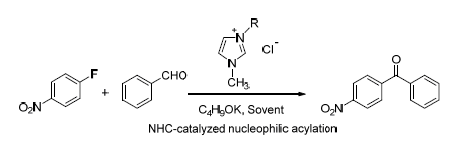| [1] Wöhler, F.; Liebig, J. Ann. Pharm. 1832, 3, 249.
[2] Lapworth, A. J. J. Chem. Soc. 1903, 83, 995.
[3] Ukai, T.; Tanaka, R.; Dokawa, T. J. Pharm. Soc. Jpn. 1943, 63, 296.
[4] Arduengo, A. J.; Harlow, R. L.; Kline, M. J. Am. Chem. Soc. 1991, 113, 361.
[5] Yu, H.-Z.; Fu, Y.; Liu, L.; Guo, Q.-X. Chin. J. Org. Chem. 2007, 27, 545 (in Chinese).(于海珠, 傅尧, 刘磊, 郭庆祥, 有机化学, 2007, 27, 545.)
[6] Sun, X.-Y.; Wu, J. Chin. J. Org. Chem. 2006, 26, 745 (in Chinese).(孙小宇, 吴劼, 有机化学, 2006, 26, 745.)
[7] Qu, M.-N.; He, J.-M. Chin. J. Org. Chem. 2011, 31, 1388 (in Chinese).(屈孟男, 何金梅, 有机化学, 2011, 31, 1388.)
[8] Ca, X.-H.; Xie, B. Chin. J. Appl. Chem. 2013, 30, 123 (in Chinese).(蔡下华, 谢兵, 应用化学, 2013, 30, 123.)
[9] Bugant, X.; Glorius, F. Chem. Soc. Rev. 2012, 41, 3511.
[10] Chai, H. X.; Li, J. R.; Yang, L. P.; Liu, M. X.; Yang, D. L.; Zhang, Q.; Shi, D. X. Chin. J. Chem. 2014, 32, 865.
[11] Enders, D.; Kallfass, U. Angew. Chem., Int. Ed. 2002, 41, 1743.
[12] Mennen, S. M.; Gipson, J. D.; Kim, Y. R.; Miller, S. J. J. Am. Chem. Soc. 2005, 127, 1654.
[13] Enders, D.; Niemeier, O.; Balensiefer, T. Angew. Chem., Int. Ed. 2006, 45, 1463.
[14] Liu, Q.; Rovis, T. J. Am. Chem. Soc. 2006, 128, 2552.
[15] Li, Y.; Shi, F. Q.; He Q. L.; You, S. L. Org. Lett. 2009, 11, 3182.
[16] Xie, Y.-M.; Wu, J.; Chao, X.-J. Chem. Bioeng. 2011, 28, 10 (in Chinese).(谢益明, 吴杰, 晁雪静, 化学与生物工程, 2011, 28, 10.)
[17] He, M., Gerson, J. U.; Jeffrey, W. B. J. Am. Chem. Soc. 2006, 128, 15088.
[18] Yu, F. L.; Jiang, J. J.; Zhao, D. M.; Xie, C. X.; Yu, S. T. RSC Adv. 2013, 3, 3996.
[19] Yu, F.-L.; Dou, Y.-T.; Zhao, D.-M.; Xie, C.-X.; Yu, S.-T. Chin. J. Org. Chem. 2014, 34, 1190 (in Chinese).(于凤丽, 窦有涛, 赵冬梅, 解从霞, 于世涛, 有机化学, 2014, 34, 1190.)
[20] Yu, F.-L.; Zhao, D.-M.; Xie, C.-X.; Yu, S.-T. Chemistry 2014, 76, 712 (in Chinese).(于凤丽, 赵冬梅, 解从霞, 于世涛, 化学通报, 2014, 76, 712.)
[21] Grasa, G. A.; Kissling, R. M.; Nolan, S. P. Org. Lett. 2002, 4, 3583.
[22] Suzuki, Y.; Yamauchi, K.; Muramatsu, K.; Sato, M. Chem. Commun. 2004, 2770.
[23] Kano, T.; Sasaki, K.; Maruoka, K. Org. Lett. 2005, 7, 1347.
[24] Suzuki, Y.; Toyota, T.; Imada, F.; Satoa, M.; Miyashita, A. Chem. Commun. 2003, 1314.
[25] Suzuki, Y.; Ota, S.; Fukuta, Y.; Ueda, Y.; Sato, M. J. Org. Chem. 2008, 73, 2420.
[26] Suzuki, Y.; Toyota, T.; Miyashita, A.; Sato, M. Chem. Pharm. Bull. 2006, 54, 1653. |
